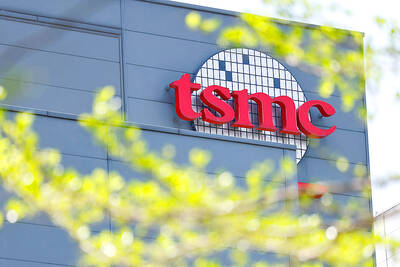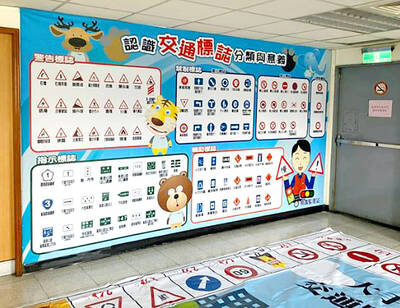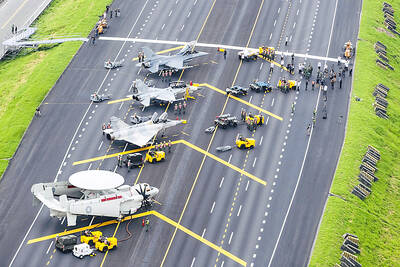The crew of the International Space Station sought refuge in a Soyuz space capsule on Thursday amid a threatened close encounter with a debris cloud, highlighting the growing dangers of space junk.
The scare arose when the three-member crew learned too late to take evasive action as an approaching cloud of debris exposed the space station to the risk of a potentially catastrophic collision.
NASA appeared most concerned about a piece of a satellite motor that was close enough to ordinarily have forced the space station to undertake an evasive maneuver.
But Laura Rochon, a NASA spokeswoman at the Kennedy Space Center in Florida, had said the risk of collision was “very low.”
“The piece itself is about one-third of an inch [8.5mm] and it’s about 4.5 kilometers away,” she said.
Americans Mike Fincke, the mission commander, and Sandy Magnus, the No. 2 flight engineer, as well as their Russian colleague Yuri Lonchakov, the No. 1 flight engineer, exited the space craft and battened themselves down in the Soyuz spacecraft.
NASA said the move was a precaution in case the crew needed to detach from the space station.
Crew members had half-locked the Soyuz doors and would have been ready to slam the hatches shut “and quickly depart the station in the unlikely event the debris had collided with the station and caused a depressurization,” NASA said.
The all-clear was sounded at 12:45pm EDT (4:45pm GMT) about 10 minutes after the crew entered the capsule, the space agency said.
“The debris threat to the International Space Station has passed,” NASA said in a statement.
The US Strategic Command (STRATCOM) notified NASA of the debris field late on Wednesday, but NASA said it was too late for flight controllers to coordinate a “debris avoidance” maneuver.
“Every once in a while, the crew has to do orbital debris avoidance maneuvers but this time they didn’t do that because we have an upcoming launch possibly on Sunday and they need to stay at the same altitude,” Rochon said.
The US Joint Space Operations Center tracks about 18,000 objects in orbit, so many that it has to decide which to follow most closely, like those that might fly by the International Space Station or manned space flights.
Experts estimate that there are more than 300,000 orbital objects measuring between 1cm and 10cm in diameter and “billions” of smaller pieces.
Traveling at speeds of up to thousands of kilometers an hour they pose a risk of catastrophic damage to spacecraft.
Last month, a spent Russian satellite collided with an Iridium communications satellite, showering more debris in an orbit 436km above the space station.
US military trackers failed to anticipate that collision, the first between two intact satellites, the Pentagon said at the time.
The worst debris clouds are in low Earth orbit (LEO), between 800km and 1,500km above the Earth, and in geostationary orbit, about 35,000km up.

EUROPEAN TARGETS: The planned Munich center would support TSMC’s European customers to design high-performance, energy-efficient chips, an executive said Taiwan Semiconductor Manufacturing Co (TSMC, 台積電), the world’s largest contract chipmaker, yesterday said that it plans to launch a new research-and-development (R&D) center in Munich, Germany, next quarter to assist customers with chip design. TSMC Europe president Paul de Bot made the announcement during a technology symposium in Amsterdam on Tuesday, the chipmaker said. The new Munich center would be the firm’s first chip designing center in Europe, it said. The chipmaker has set up a major R&D center at its base of operations in Hsinchu and plans to create a new one in the US to provide services for major US customers,

The Ministry of Transportation and Communications yesterday said that it would redesign the written portion of the driver’s license exam to make it more rigorous. “We hope that the exam can assess drivers’ understanding of traffic rules, particularly those who take the driver’s license test for the first time. In the past, drivers only needed to cram a book of test questions to pass the written exam,” Minister of Transportation and Communications Chen Shih-kai (陳世凱) told a news conference at the Taoyuan Motor Vehicle Office. “In the future, they would not be able to pass the test unless they study traffic regulations

GAINING STEAM: The scheme initially failed to gather much attention, with only 188 cards issued in its first year, but gained popularity amid the COVID-19 pandemic Applications for the Employment Gold Card have increased in the past few years, with the card having been issued to a total of 13,191 people from 101 countries since its introduction in 2018, the National Development Council (NDC) said yesterday. Those who have received the card have included celebrities, such as former NBA star Dwight Howard and Australian-South Korean cheerleader Dahye Lee, the NDC said. The four-in-one Employment Gold Card combines a work permit, resident visa, Alien Resident Certificate (ARC) and re-entry permit. It was first introduced in February 2018 through the Act Governing Recruitment and Employment of Foreign Professionals (外國專業人才延攬及雇用法),

‘A SURVIVAL QUESTION’: US officials have been urging the opposition KMT and TPP not to block defense spending, especially the special defense budget, an official said The US plans to ramp up weapons sales to Taiwan to a level exceeding US President Donald Trump’s first term as part of an effort to deter China as it intensifies military pressure on the nation, two US officials said on condition of anonymity. If US arms sales do accelerate, it could ease worries about the extent of Trump’s commitment to Taiwan. It would also add new friction to the tense US-China relationship. The officials said they expect US approvals for weapons sales to Taiwan over the next four years to surpass those in Trump’s first term, with one of them saying